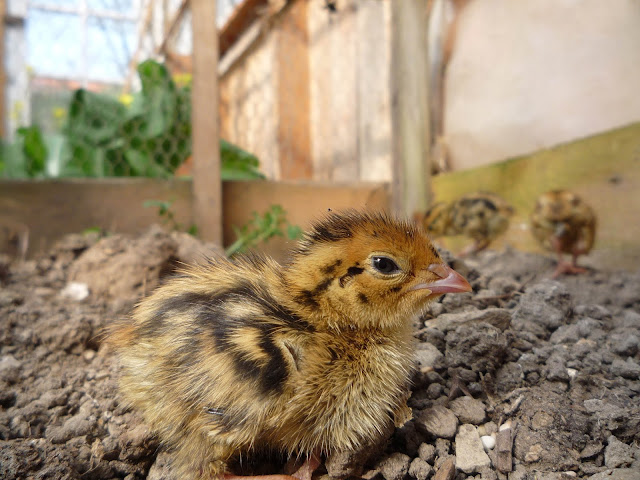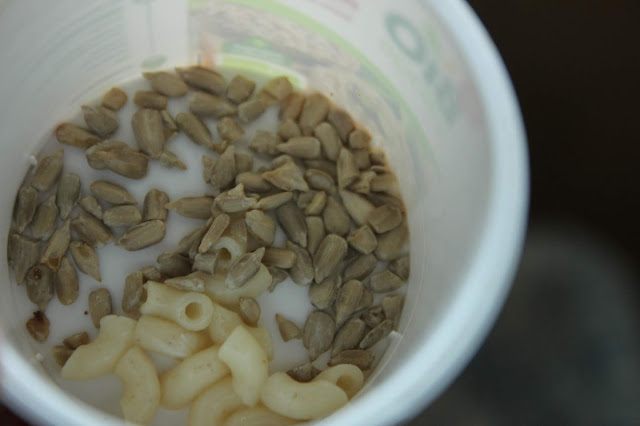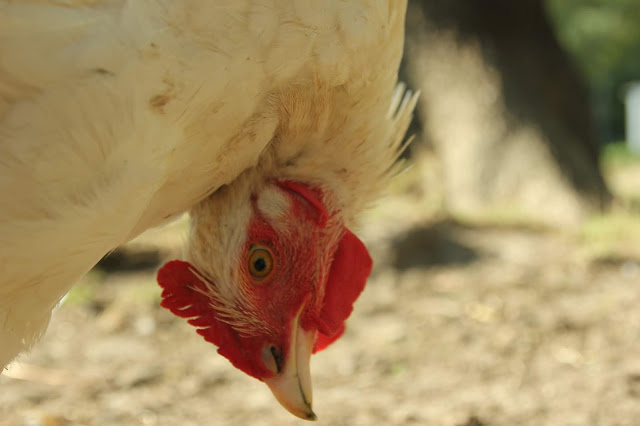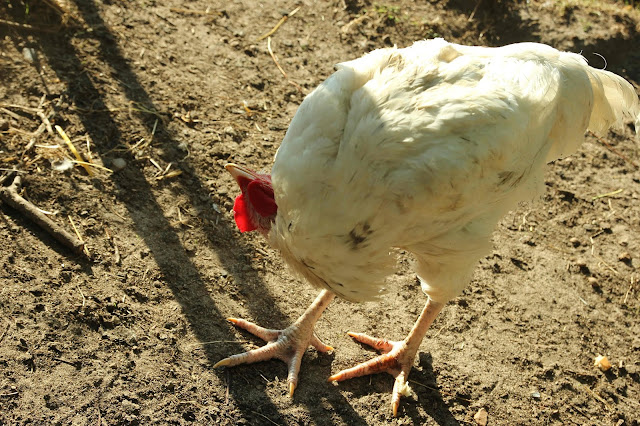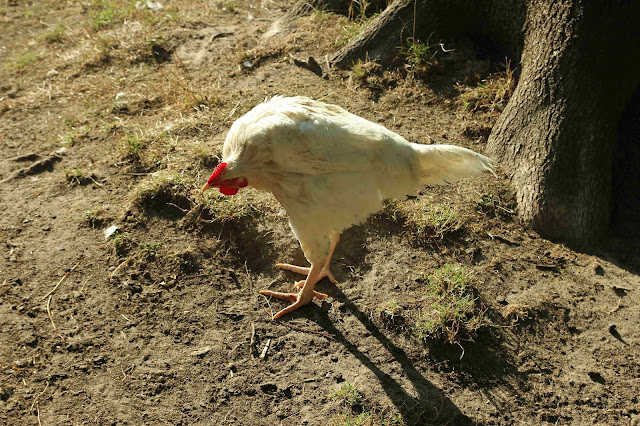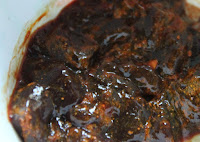As explained in Part One, Mr Upside Down is not my bird but I had some prior knowledge of his case which helped in my initial assessment. This being; that he was hatched from a purchased egg and didn't have wry neck at hatch. Thus his condition was most likely to be down to nutrition rather than physical problems, such as malpositioning within the egg. However, as many nutritional deficiencies are in fact due to parental diet and its impact upon the quality of the embryo's nutrition, they do therefore start within the shell. Thus purchased hatching eggs can be an issue. Furthermore, all birds are individuals and thus a more gentle, less aggressive chick can become ever more deficient as time goes on. It is not always a question of food availability but individual food consumption, thus hand-feeding with 'time-out' is so important to effect a cure.
Chronic deficiency, particularly of the water-soluble B
Vitamins, selenium and crucial amino acids such as L-methionine, has often been my experience in quail chicks, witness my little chick above, where due to lack
of available eggs, I have been forced to buy from large industrial
hatcheries. Shortly after
hatch I noticed this chick spent a great deal of time sitting rather than foraging
with his siblings. In fact the day after this photo was taken, my little chick began to limp and I began to suspect the onset of
curled toe paralysis (Vitamin B₂ Riboflavin deficiency - see Related Articles below). The success and speed of cure I experienced with this quail chick led me on to further individual research and application of nutritherapy both for my poultry and in my own life and spectacularly with shingles in particular. A comprehensive course of nutrient dense foods is therefore what I had planned for Mr Upside Down.
Thus having establishing a more important position within the flock by giving Mr Upside Down some time out and the additional status of being hand-fed, I will now detail the diet I put him upon to try and effect a cure. This was with the proviso that from everything I had read, in an older bird with wry neck, this regime needed to span several weeks and possibly even continue after the symptoms disappeared to be assured of a complete and sustained recovery. The sad part being, I did not have longer than the two week period of my neighbours' vacation.
Mr Upside Down's Nutritherapy in Detail
My initial worry was that because his wry neck made it difficult for him to eat, he had found that sticking his upside down head in the 'serve-yourself' grain bin provided by his owners, was his best method of keeping himself 'full'. I saw him doing this on several occasions and so deduced that he was actually exacerbating his condition ironically by preventing himself from starving to death! My task therefore was to get to him as early in the day as possible and feed him up with nutritious food before he hit the grain. In my opinion, a dry granivorous diet is not a good one for any of the galliformes and grain actually depletes Vitamin A. Just to give you an idea of its importance, a deficiency of this vitamin in the diet or any other of the 13 vitamins listed below can induce neurological illness.
The full list is as follows:
- Vitamin A
- Vitamin B₁ Thiamine
- Vitamin B₂ Riboflavin
- Vitamin B₃ Niacin
- Vitamin B₅ Pantothenic Acid
- Vitamin B₆ Pyridoxal-5-Phosphate
- Vitamin B₇ Biotin
- Vitamin B₉ Folate
- Vitamin B₁₂ Cobalamin
- Vitamin C
- Choline (mineral/vitamin often grouped with the B complex vitamins)
- Vitamin D₃
- Vitamin E
These particular vitamins are only part of the nutritherapy however, as there are attendant minerals which are are not only useful in themselves but act as transporters for the vitamins. In the case of Vitamin A, for example, zinc is necessary to get it moved to where it can do most good. It is also only part of the story too, as many vitamins, minerals and other foodstuffs must work in synergy. For example, there is a link between
the storage, transport and utilisation of Vitamin A and the intake of
protein. The quality of the protein also seems to have an important role
in Vitamin A metabolism. Thus when trying to get the optimum nutrition into a bird, as quickly as possible because of its condition, it is important to choose a paletable food that is as nutrient-rich as possible. So my number one go-to eatable is:
Beef Liver (or if unavailable Hard Boiled Egg)
Liver is one of natures most concentrated sources of Vitamin A and although this vitamin can be obtained from plant sources, its precursor being beta-carotenes from brightly coloured fruit and vegetables, the conversion process is dependent on the body already containing sufficient fat. As this cockerel had wry neck, one of the major vitamin deficiencies being that of Vitamin E, his fat levels were likely to be extremely low. Furthermore as not every human is genetically able to convert betecarotenes to Vitamin A, I'm one of them, there is no reason for me to think that every bird can either. Vitamin A is also responsible for the assimilation of proteins, minerals and water soluble vitamins and as liver contains a whole panoply of these as well, you are getting a great all in one package deal when you feed it including, apart from Vitamin A:
- Vitamins D, E, K₂, and the B complex vitamins (including the big DNA hitters B₁₂ Cobalamin and Vitamin B₉ Folate)
- Omega-3 fats
- Trace minerals like copper, zinc, iron and chromium
- Coenzyme Q10 (CoQ10) which is an antioxidant with the ability to protect the cells from the damage of oxidative stress, which is one of the major risk factors for neurogenerative conditions.
- Purines - needed for cell function; to produce energy and molecular synthesis
I had to hand feed Mr Upside Down his liver on the first day because he was unable to stand up to eat. However, I did quickly realise that he was frightened both of me and of the other cockerels and that putting his feet securely down on terra firma or rather the grain bin helped both to stabilise him physically and to relieve his stress. I also spent a time handling and talking to him because I wanted him to trust me and thus lower his stress levels, this made him much easier to feed, even when as with my next nutrients I had to actually put them in his beak:
Coconut Oil & Turmeric Lettuce Parcels
 On the second day I made the mistake of powdering his liver with turmeric. He disliked the taste so much he actually stopped eating it and I had to revert to hand feeding him. I really needed to do this to get some curcumin into him as I deduced that with the length of time he had already had wry neck there could be some neuron damage. Curcumin or diferuloylmethane, one of the amazing active ingredients in turmeric, is one of the few compounds capable of enhancing neurogenesis, the regrowth and repair of these vital nerve cells.
On the second day I made the mistake of powdering his liver with turmeric. He disliked the taste so much he actually stopped eating it and I had to revert to hand feeding him. I really needed to do this to get some curcumin into him as I deduced that with the length of time he had already had wry neck there could be some neuron damage. Curcumin or diferuloylmethane, one of the amazing active ingredients in turmeric, is one of the few compounds capable of enhancing neurogenesis, the regrowth and repair of these vital nerve cells.In order to facilitate giving him a higher dosage I decided to fool him by parceling up the turmeric and coconut oil mix in lettuce, both the latter he had already tasted and loved. I should have known better, he was too clever for me. From my observations of my flock, I'd deduced that birds not only have great eyesight but also a good sense of smell and taste which enables them to differentiate flavours. Finally I had to feed him this fancy apéritif snack but the trouble was worth it as he swallowed a goodly amount at one go!
Coconut oil is a wonderful substance it contains a large amount (50%) of lauric acid, which in its immune system support is the nearest thing to mother's milk. A bird low in essential nutrients is also susceptible to contract other conditions and illnesses, so keeping the immune system at an optimum, is really important. Coconut oil helps in the digestion and thus assimilation of foods in particular Vitamins A, D, E and K. As I wasn't sure how much non-edible fibre this cockerel had managed to consume and thus his ability to promote and maintain optimum gut flora, this again made lauric acid an important element in his diet. Coconut oil, though a fat, acts like a carbohydrate, in that it gives the body an immediate energy boost, so this too was a much needed factor to get Mr Upside Down back on his feet - literally.
Wild Invertebrate Protein - Woodlice/Sowbugs & Mealworms
I know I'm always banging on about chicken 'paleo' diets but as referenced in his PhD thesis of 2005, Bassler¹ actually stated that insects and other invertebrates
provide around four times more usable protein
and energy for chickens and other poultry by
weight, compared to poultry feed rations.
In his 1909-1911 study, Beebe² had a most interesting observation to make about wild jungle fowl and pheasants foraging in the areas of their habitat which had been overtaken by farming:
In his 1909-1911 study, Beebe² had a most interesting observation to make about wild jungle fowl and pheasants foraging in the areas of their habitat which had been overtaken by farming:
'...the birds do very little damage to the crops, and even when they make a regular practice of appearing among the grain morning and evening, it is the insect life which is the principal attraction.'
Wild and organically raised invertebrates provide readily bioavailable and easily assimilable protein and fats as well as a whole panoply of vitamins and minerals and are of immeasurable help when treating a nutrient-deficient bird.
It is also interesting to note that at crucial times of their development and for physical and nervous system growth, such as when chicks in the nest, birds, not normally dedicated insectivores, will be fed on a totally invertebrate diet. Therefore, to my mind a bird needing cell repair and regeneration should be fed similarly. A bird's understanding of its optimum diet has always been my guide.
It is also interesting to note that at crucial times of their development and for physical and nervous system growth, such as when chicks in the nest, birds, not normally dedicated insectivores, will be fed on a totally invertebrate diet. Therefore, to my mind a bird needing cell repair and regeneration should be fed similarly. A bird's understanding of its optimum diet has always been my guide.
Grapes
I am repeatedly amazed when the black Muscat grapes are ripe in our garden to see my mother hens expending so much energy jumping and flying up to pick the fruits for their chicks. Mother knows best; as in so doing they are providing them with quite a package of nutrients, including Vitamin C and many of the B complex vitamins. However, these powerful fruits are perhaps best known for their content of the antioxidant pigment; resveratrol. This, as with the antioxidants contained in liver, has an important impact upon protecting Mr Upside Down from further and potential neurogenerative damage due to oxidative stress.
Lettuce
There are many green leafy vegetables which contain Vitamin B₉ Folate but I thought lettuce would be the easiest for him to break off and consume. This vitamin works in synergy with B₁₂ Cobalamin, so it is necessary to feed both. Herein lies the whole beauty of nutritherapy because to my mind vitamin supplementation can be confusing and sometimes even counter productive. The media, dictionaries, the
internet and even health professionals confuse the naturally occurring Vitamin B₉ Folate with folic acid and use both as if
they are the same, they are not! Folic acid is a synthetic version of the
vitamin which not only needs to be converted by the body back into the natural form but it also leaves a chemical residue in the body. However and even more worryingly folic acid does not work in synergy with Vitamin B₁₂ it actually depletes it!
Sunflower Seeds, Yeast Flakes & Brazil Nuts
Sunflower seeds are a great source of Vitamin E, Selenium and Thiamine Vitamin B₁ and also very much appreciated by birds in my experience, so easy to feed. As already stated above the body needs 13 vitamins for the brain and nervous system to function correctly, including the most important group of vitamins to this end; the B vitamins. This group consist of eight members, important because they help with cognitive function, nervous system and brain health, as well as red blood cell formation. However, Vitamin B₁ Thiamine, arguably plays the biggest role; supporting the crucial flow of electrolytes in and out of the nerve and muscle cells, as well as metabolizing those carbohydrates and lipids found in foodstuffs. Thiamine helps convert the food to energy, especially for organs that use a great deal of it, such as the brain and nervous system. In effect, the brain can be severely compromised by a thiamine deficiency, which also results in the loss of co-ordination.
Yeast flakes are also something I always have in the kitchen cupboard/first aid kit. In our local organic shop they are sold in bulk and as they are hydroscopic it's a good idea to keep them in an air tight container, on hand for emergencies. Rich in vitamins and minerals they're a great way of getting several of the B complex vitamins into your birds, such as Vitamin B₁ Thiamine,
Vitamin B₂ Riboflavin and
Vitamin B₃ Niacin. Yeast flakes are to my mind an acquired taste but I am always really surprised when even quite small quail chicks seem to enjoy eating them. In order to facilitate the cockerel's ability to eat them I did add some sticky pasta, which I knew he would eat, into the mix as well as coconut oil and even from time to time slipped in some turmeric.
Selenium is something that is needed in very small amounts but without it a bird can become crippled and die. In the case of wry neck it is also pretty much a certainty that the bird is deficient in this mineral and the very best way to get selenium into Mr Upside Down is the Brazil nut. This is however quite a tricky process and as selenium is toxic in large amounts and as the recommended allowance for Brazil nuts is around three per day for a human, the dosage for even a largish cockerel is tiny. I usually just take four or five gratings from the end of the nut and add them to the pasta mix.
N.B. You can also get selenium as a transdermal spray! I have found this an ideal delivery to treat the smaller chicks and quail particularly when belonging to my neighbours and friends, the former have no bond with me, so it is quick and a lot less stressful for them.
He now seemed to be much happier to lie down with the rest of the flock and soak up the sun without appearing ill at ease. This with the proviso that he still seemed happiest when surrounded by his three loyal hen friends.
Until next time, all the very best from Normandie! Sue
..and now here's the film:
Selenium is something that is needed in very small amounts but without it a bird can become crippled and die. In the case of wry neck it is also pretty much a certainty that the bird is deficient in this mineral and the very best way to get selenium into Mr Upside Down is the Brazil nut. This is however quite a tricky process and as selenium is toxic in large amounts and as the recommended allowance for Brazil nuts is around three per day for a human, the dosage for even a largish cockerel is tiny. I usually just take four or five gratings from the end of the nut and add them to the pasta mix.
N.B. You can also get selenium as a transdermal spray! I have found this an ideal delivery to treat the smaller chicks and quail particularly when belonging to my neighbours and friends, the former have no bond with me, so it is quick and a lot less stressful for them.
Getting some rays
Feeding foods rich in the B complex vitamins, proteins and fats had a resultant good effect on his nervous system. This coupled with handling and hand feeding to improve his status, had a knock-on effect in Mr Upside Down's ability to create Vitamin D₃.He now seemed to be much happier to lie down with the rest of the flock and soak up the sun without appearing ill at ease. This with the proviso that he still seemed happiest when surrounded by his three loyal hen friends.
In conclusion
On of the factors you may believe I haven't touched on here and which is oft cited as a cause of wry neck, is genetic predisposition. In fact I have done so because the inability of an individual to assimilate essential minerals, vitamins, etc.,. unless given in the natural food form is included in my argument. If the content of the egg is deficient and thus the parent deficient then the chances are both adult and chick, as in the case of commercially bought eggs, have been subjected to a granivorous and/or pelleted food diet from which they are unable to obtain the full range of essential nutrients. Thus even if one considers that torticollis has a genetic element, this in no sense precludes treatment by food!
One thing I have left out however, is delivery by hand feeding. It is a difficult subject, never mind activity, particularly if the bird is not your own and one which requires not only a separate article but also a film, both of these will be available in the near future. Thanks for dropping by and do feel free to share experiences or ask for further information in the comment section. If you have enjoyed this piece and found it
useful think about sharing it with your family and friends, on social media and also maybe about joining this blog
and/or subscribing to my Youtube channel or even supporting us on
Patreon or
It all helps to keep me going!Until next time, all the very best from Normandie! Sue
..and now here's the film:
References:
¹Bassler, A. 2005. Organic broilers in floorless pens on pasture. PhD Thesis. Swedish University of Agricultural Sciences, Uppsala, Sweden. http://pub.epsilon.slu.se/859
²Beebe, W. 1918-1922.
A monograph of pheasants (4 vols). London, H.F. Witherby & Co (This
study was also considered by many later academics in the same field to
be a seminal work on the Jungle Fowl) This work was later issued in
abridged form with the title: Pheasants, their lives and homes, in 1926
RELATED ARTICLES
Wry Neck/Torticollis Part 1 What is it & Initial Treatment
This is a departure from my usual format, in that this was an open-ended treatment with no definite conclusion because I just had two weeks with this very courageous bird...read more
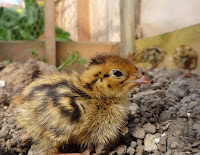 Identification of riboflavin deficiency in purchased quail and hatching eggs
Identification of riboflavin deficiency in purchased quail and hatching eggs
Quail have a high basal metabolic rate and as such their problems with nutrition are dramatically and rapidly revealed...read more
 Cure curled toe paralysis (riboflavin deficiency)
Cure curled toe paralysis (riboflavin deficiency)
For my 'field study', I am using the example of quail chicks, from
non-organic purchased hatching eggs because this is the area in which,
sadly I have a great deal of experience ..read more

